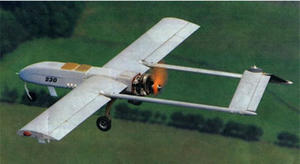UAV updateThe laser designator-equipped Shadow UAV offers smart bombs more precision
The light weight laser designators enable the UAV to designate targets for laser guided smart bombs when more accuracy than GPS guided weapons is needed: GPS guided weapons hit within a 10 meter/31 foot circle, while laser guidance is good for 1-2 meters, or 3-6 feet

The Shadow 200 laser-designating UAV in flight // Source: defenseindustrydaily.com
Two years ago, the U.S. Army began installing a lightweight laser designator in some of its RQ-7B Shadow 200 UAV. This enabled the UAV to designate targets for laser guided smart bombs. This is useful for when you need more accuracy than GPS guided weapons (which hit within a 10 meter/31 foot circle, while laser guidance is good for 1-2 meters [3-6 feet]). The laser designator proved so successful, that the army and marines are installing them in most of their Shadows. In addition, Shadows are being equipped with a larger wing, that carries more fuel, and enables them to stay in the air for up to nine hours.
Strategy Page writes that even with just the GPS and laser range finder, however, the Shadow can spot for the large number of GPS and laser guided munitions coming from other sources. These include the hundred pound 155mm Excalibur (with 9 kg/20 pounds of explosives), the 600 pound MLRS rocket (with 150 pounds of explosives) or the 1.5 ton ATACMS rocket (with 223 kg/500 pounds of explosives). This has proved very useful, because the Shadow can stay in the air long enough to catch the enemy doing something, and allowing an army shell or rocket to be quickly brought into play to deal with the situation.
Each 164 kg/360 pound Shadow 200 UAV costs $600,000. A day camera and night vision camera is carried on each aircraft. Able to fly as high as 5,000 meters/15,000 feet (or more), the Shadow can thus go into hostile territory and stay high enough (over 3,200 meters/10,000 feet) to be safe from hostile rifle and machine-gun fire. The Shadow UAVs can carry 45 kg/100 pounds of equipment., is 3.6 meters/eleven feet long and has a wingspan of that has been increased from 4.1 meters/12.75 feet to 6.5 meters/20 feet. The larger wing is hollow and carries more fuel, enabling the UAV to stay in the air longer. The new wing also has hard points for two light weight missiles (like the 11.4 kg/25 pound laser guided 70mm rockets or the 2.7 kg Spike). The Shadow has a range of about 50 kilometers from its controller (the operator and radio gear).
Strategy page notes that while scheduled for replacement by the larger MQ-1C, the Shadow is still in production, and more than 300 will be produced before it ends. More than 500 of the MQ-1Cs are planned. The Shadow is not as capable as the MQ-1C, but it is reliable and gets the job (air recon for combat brigades) done.
The MQ-1C weighs 1.5 tons, carries 135.4 kg/300 pounds of sensors internally, and up to 227.3 kg/500 pounds of sensors or weapons externally. It has an endurance of up to 36 hours and a top speed of 270 kilometers an hour. SMQ-1C has a wingspan 18 meters/56 feet and is 9 meters/28 feet long. The MQ-1C can land and take off automatically, and carry four Hellfire missiles (compared to two on the Predator), or a dozen smaller 70mm guided missiles. The original MQ-1 Predator is a one ton aircraft that is 8.7 meters/27 feet long with a wingspan of 15.8 meters/49 feet. It has two hard points, which usually carry one (47 kg/107 pound) Hellfire each. Max speed of the Predator is 215 kilometers an hour, max cruising speed is 160 kilometers an hour. Max altitude is 8,000 meters/25,000 feet. Typical sorties are 12-20 hours each.
